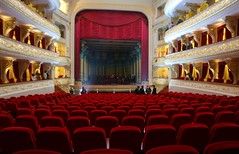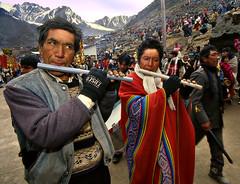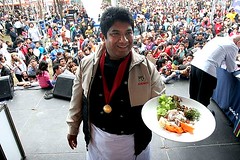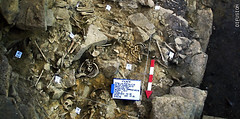US Expat Barbara Drake talks about the win by La Teta Asustada of best film at the Berlin film festival last week and about other notable works covering a dark period of contemporary Peruvian history.
Category: "History"
Huaca Huallamarca
In the heart of lush residential San Isidro, the Huaca Huallamarca is one of dozens of pre-Columbian sites found within the city of Lima – a densely populated area even then. Heavily restored and open to tourists, the pyramid sits surrounded by huge modern penthouses that are a stark and unusual contrast for such an ancient ruin.
The last stop – Nostalgia Street
Public transport in Lima used to be orderly, clean, efficient and safe. Bus routes ran across the city in an organised way, drivers and ticket sellers were gentlemanly and vehicles were uniform and spacious. This all changed with the Presidency and quasi-dictatorship of Alberto Fujimori in the 1990s, something that the old-timers of the transport industry lament.
Lima of yesteryear – 1920s to 1970s
The Lima of two periods of time are both equally well known; the colonial and modern Lima that is still visible in the area around the city’s plaza, and the modern noisy metropolis that extends for kilometres.
But what about the time in between?
Bones of a conqueror
The Spanish settlers in Spain, upon their deaths, often wanted to be buried beneath the churches they had built on what they considered foreign and certainly un-Christian land. Doing so they thought was the only way of ensuring themselves a place in heaven. The richest or most important Spaniards in Lima were given prime spots – beneath the alter of the city’s grand cathedral. Here, when work on the church’s foundations was being carried out in 1977, a led box was found proclaiming; “Here is the head of Don Francisco Pizarro, Don Francisco Pizarro who discovered Peru and presented it to the crown of Castile.”
Casa de Osambela-Oquendo
This mansion in the colonial heart of Lima is as beautiful as it is unique. In its 200 year history it has seen two wealthy owners come and go, leaving it with two names. I happened to be passing by when Lizardo Retes, who takes care of the site that is now a cultural centre, offered to show me around – and to the roof where you can see as far as Callao.
Los Ñaupa
They existed in a time before our time, in a world that existed before ours. These beings inhabited the planet long before us and were called the Ñaupa by the indigenous peoples of the central Andes.
Their earth was different from ours. There were no bright days or dark nights, just an ambient glow and a steady temperature. When this began to change and the great Inti, the sun god, brought night and day to the world, the Ñaupa retreated to the tallest mountains to dwell within them.
Paredones, Nazca
The Incas also arrived in the Nazca plains, albeit about 1000 years after the Nazca culture faded from existence. The people of these desert valleys still lived as they once did, maintaining the irrigation canals of their ancestors and producing textiles of similar quality with similar patterns. After being dominated by the Wari they were accustomed to the idea of foreign rule and submited to the Incas easily.
Inca Garcilaso de la Vega
Born in Cuzco in 1539, Garcilaso de la Vega was the son of Spanish conqueror Sebastián Garcilaso de la Vega y Vargas and Inca princess Palla Chimpu Ocllo. He grew up in the earliest years of the Spanish empire, just when the conquered Incas were becoming used to Spanish rule. He lived among and was related to indigenous Peruvians who were alive in the days of Huascar’s rule in Cuzco and his subsequent battle with half-brother Atahualpa, as well as those who were alive during the rule of Huayna Capac.
He grew up learning both Quechua and Spanish while living with his mother – until he turned 10. It was then, with the death of his father who had long since abandoned the family, he decided to go to study in Spain with the 4,000 pesos he had received as an inheritance.
Lost ruins of Kantupata
One of the steepest slopes delays us enough to observe the immensity of the view, and while the wind almost blows us off the mountain, we discover that before our eyes Machu Picchu is in view… but from an angle we have never seen before, not even in photos. The view is, how can I say, from behind. It is really stunning to behold.
Kantupata announces itself with a grand stairway of stone, which once cleaned-up by the archaeologists is truly impressive.
We continued on to a place that has particular impact. A large plaza with a shrine in the centre, surrounded by buildings and walls. Below, with a view of the peaks in the distance, more stone farming terraces unfold, parallel with water fountains similar to those at Wiñay Huayna.
Huacas of Manchay Alto
There’s not much left of it now, but there is something special about this temple complex in the Lurín valley that makes it so interesting. At about 3000 years old, it makes the city of Pachacamac just to the southwest look positively modern.
Air accident in San Diego reminds us of Alfredo Salazar
In 1937 Alfredo Salazar managed to crash his damaged plane in an unpopulated area of Miraflores.
Just a few days ago a horrible accident occured in San Diego, United States, when a US F-18 fighter jet plummeted into a residential zone, destroying homes and killing four people including two children. The pilot had ejected seconds before.
A similar tragedy almost occured in Peru 71 years ago. A plane completely in flames was heading was falling rapidly over the skies of Lima, heading towards Miraflores – then only a sea-side town found at the end of Av. Arequipa.






![A Tango With My New Charango [Featured]](http://farm1.static.flickr.com/13/14395819_078370ba2e_m.jpg)
![Chicha Restaurant, Cusco [Featured]](http://farm5.static.flickr.com/4101/4784536117_a4e3301c94_m.jpg)

![How to become an Olympian [Featured]](http://farm3.static.flickr.com/2696/4356910596_7d5da589e3_m.jpg)
